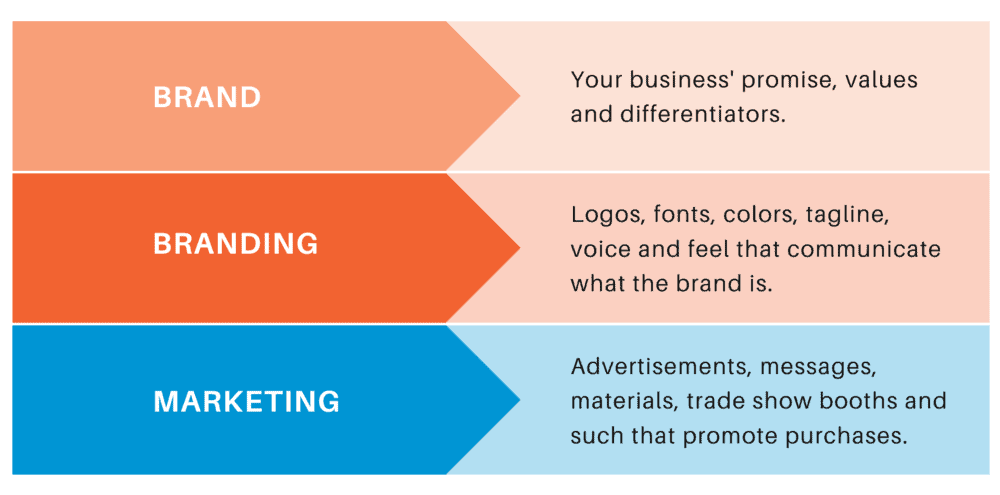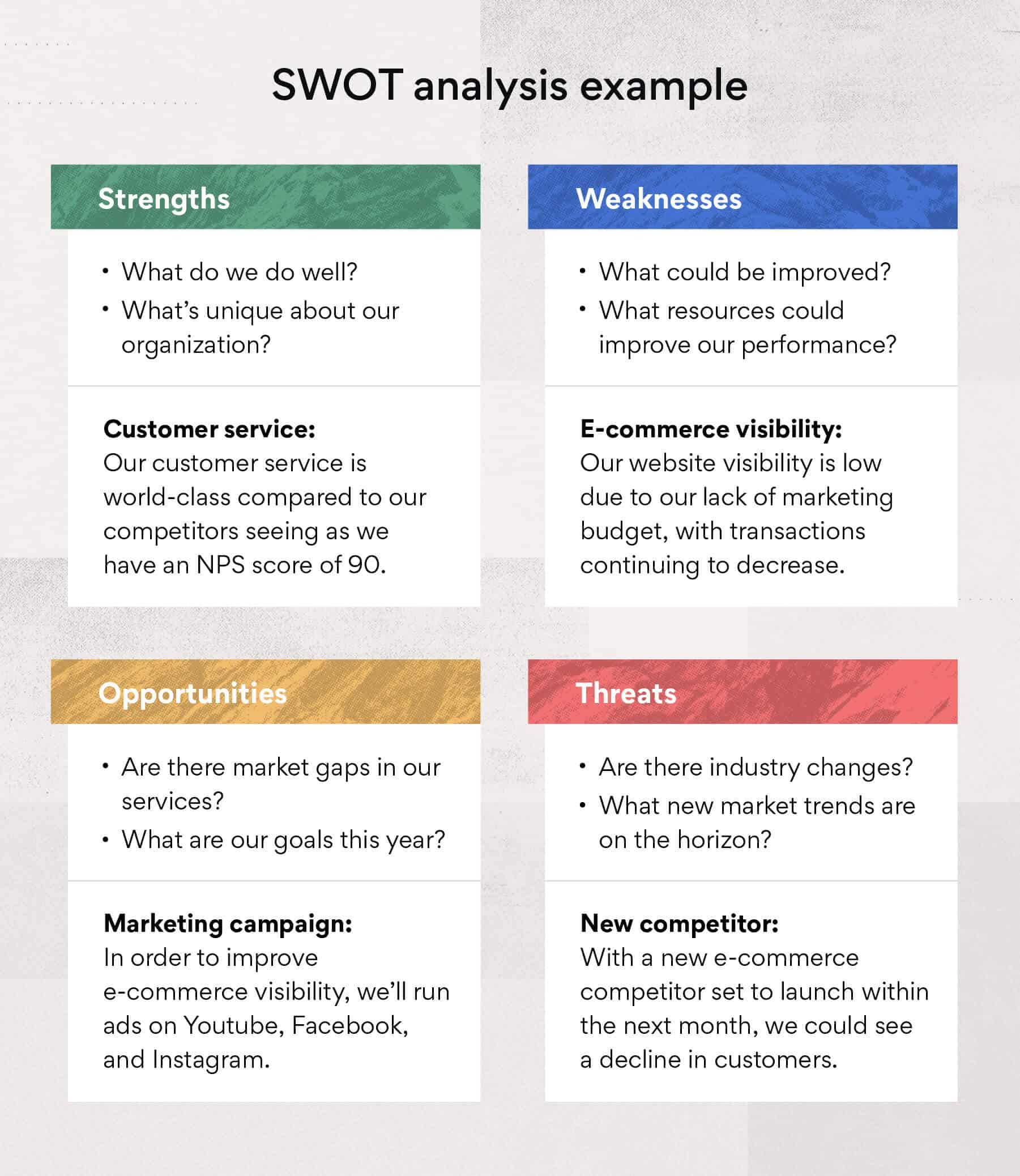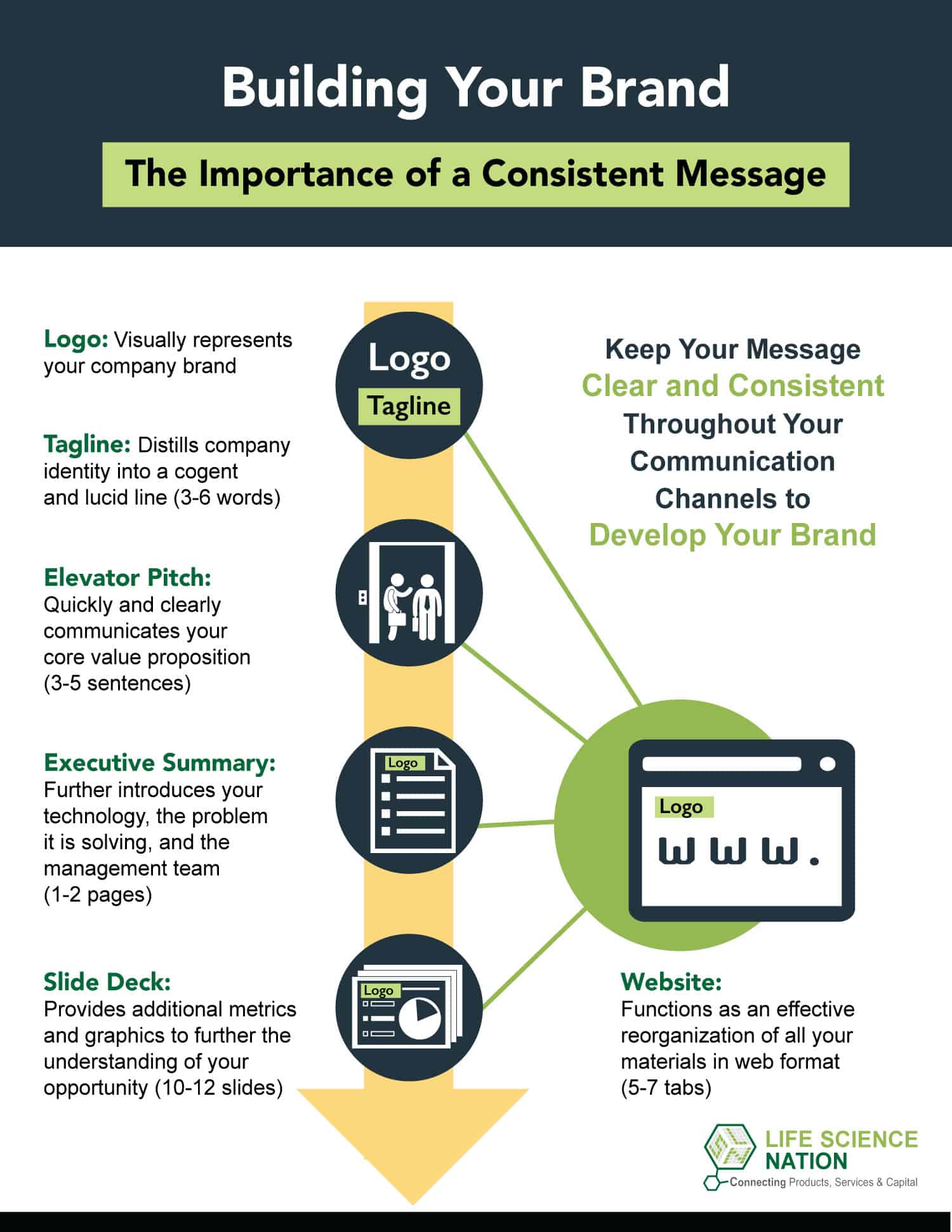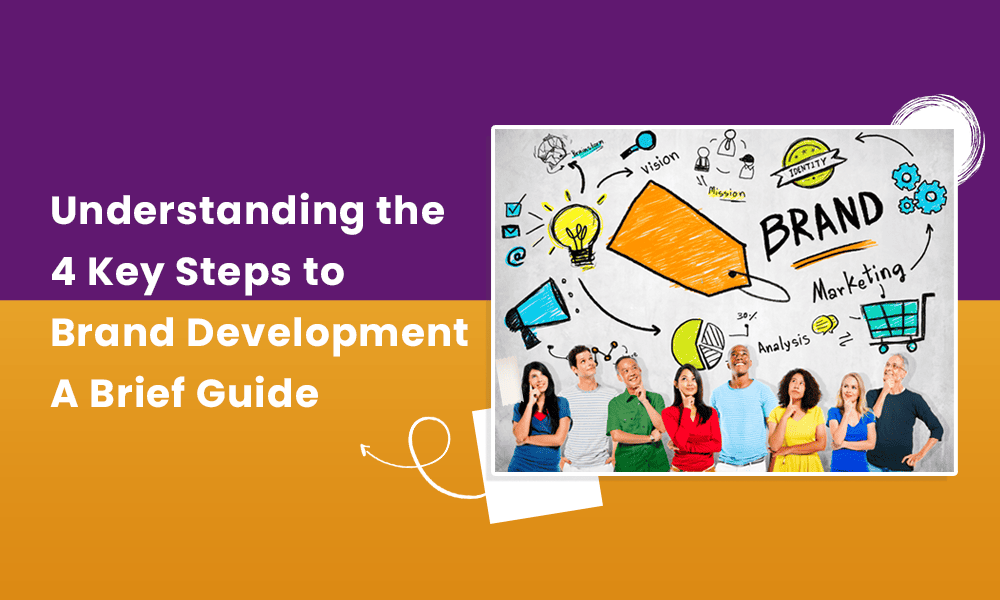A brand represents the essence of a company, serving as its blueprint and leaving a distinctive mark that distinguishes it from competitors. It encompasses everything from the company’s values and mission to its visual identity, brand voice, and customer experience.
Successful brand development goes beyond just designing a logo or crafting a tagline; it requires a deep understanding of your company’s unique value proposition, target audience, competitive landscape, and brand value.
It involves a strategic blend of research, creativity, and consistent execution to create a cohesive and strong brand identity that aligns with your company’s vision and gives your target audience a good brand experience.
In this blog post, we delve into the intricacies of taking on the brand development challenge, breaking it down into four easily manageable steps. These steps serve as a roadmap for creating and nurturing a strong and enduring brand presence.
Table of Contents
What is Brand Development
Brand development is the formulation of your brand. It includes the determining factors of how you will present your business to the world.
You’ll have to review business facets such as your target customer, your company values, your brand story, and your business goals to determine the direction of your brand development, but that’s something we’ll delve into more in the next section.
Contrary to the notion that brand development is a one-time event, it is an ongoing and dynamic process that evolves alongside the growth of the company. A static brand can quickly become outdated and fail to resonate with its target audience.
As your company expands, enters new markets, or adapts to changing industry trends, it becomes imperative to revise and refine your brand development strategies continually to boost your brand equity. This proactive approach ensures that your brand remains relevant, resonates with customers, and maintains a competitive edge in an ever-evolving marketplace.
People often confuse brand development with branding, but branding and brand development are two separate things.
Brand Development vs Branding
Creating your brand identity is a part of developing your brand. So, too, is brand management and formulating a branding strategy.
While developing your brand is about determining all that goes into it and setting a brand guideline, branding itself is about executing that development in real time.

To go back to our point from the intro, brand development is an ongoing process. It’s true that the development of your brand will happen early in the days of your startup’s history.
However, plenty of instances might require you to redefine or shift the direction of your brand, in which case redevelopment is necessary. If you switch gears and move into a new industry, for example, that calls for a new development strategy.
4 Steps to Develop Your Brand
You can’t jump into branding without developing your brand first. If you do, you’ll end up with unclear messaging about your brand and inconsistent branding from one channel or platform to another.
Each step provides valuable insights and actionable guidance to help you navigate this transformative journey successfully, whether you are starting from scratch or reevaluating your existing brand strategy.
By embracing the iterative nature of brand development and implementing these proven steps, you can establish a powerful brand that not only differentiates your company but also fosters deep connections and inspires brand loyalty from your target audience.
Here are four steps to follow to discover the basis of your own brand.
Step 1 – Understand your company
You can’t possibly develop your brand without knowing what your small business exactly is.
As a business owner, defining what your company does can be hard, which is why we recommend a SWOT analysis.
SWOT is short for Strengths, Weaknesses, Opportunities, and Threats. You’ll want to ask hard questions in each of these areas and then answer honestly.

In the strengths section, what are your current best products and services? What areas of customer service do you excel in and why? What would you say is the primary reason that customers choose your business over someone else’s who offers similar products or services?
Then, it’s time to move on to the weaknesses category. This is where a lot of businesses trip up in the honest self-assessment department 😅
You’re only hindering your brand development when you’re not truthful.
You might ask these questions: what are your competitors doing better than you? What are your weakest products and services? Have they always been that way, or did they become that way with time?
Next, you’ll move on to the opportunities portion of the SWOT analysis.
What is your competition not doing so well that you can capitalize on? Is there an ongoing market trend you can jump on before it’s not popular anymore? These are the kinds of questions that need answering.
The last part of your SWOT analysis is a review of your threats. Is there a new company in town that could usurp your hard-earned spot?
Once you’ve completed your SWOT analysis, as difficult as it might have been, you’ll feel far more prepared to develop your brand.
Read also: 8 Of The Most Clever Brand Extension Examples
Step 2 – Learn your audience
Brand development means having a finger on the pulse of what your audience needs, wants, and is interested in.
If you don’t yet know your target audience, that’s the second step of the brand development process.
You need to conduct market research and gauge who will be the most receptive to your messages, as well as your products and services. This research will influence your brand development and marketing strategy.
What motivates these people? What kinds of problems or challenges do they have, also known as pain points?
What kind of influences are already at play among your target audience that can sway their decision-making one way or another? What tools do they use to find information and make purchasing decisions?
Once you know these answers, you likewise know your audience. Then you can create content that resonates with them again and again — that’s how you build customer loyalty.
Read also: Top 7 Brand Image Mistakes SMBs Make and How to Avoid Them
Step 3 – Select your brand message and positioning
By this point, you’re about midway through your brand development, but now, here comes the parts that are most related to branding.
What is your brand message? We’ll start with that question.
Perhaps this is the first time you’re putting forth a brand message, or maybe your company has undergone some significant changes lately; you feel now is a good time for a new brand message.
Your brand message includes your value proposition and brand personality—all rolled into one. This is where having clear brand guidelines becomes essential to maintaining consistency.
You must determine how you can express your value proposition without using words, as branding is not always verbal.

Once you’ve nailed down your brand statement, you have to select your brand positioning.
Will you push your new brand message to the forefront through inbound marketing methods like digital advertising, content marketing, email marketing, social media marketing, a website redesign, or a combination of the above? How about using some old-school outbound marketing as well?
That depends on your ambitions and your budget.
Read also: Outbound Marketing Tips to (re)Brand your Company [Updated]
Step 4 – Track brand growth
The fourth and final step of your brand development journey is to watch as your brand grows.
By now, you have indeed switched from brand development to branding or deploying the strategies you worked so hard to formulate.
Brand growth manifests itself in all sorts of ways, including an increase in lead generation, more social media shares and mentions, a spike in web traffic, better SEO positioning, and more.
These are all signs that your brand growth is on the right track.
The fourth and final step of your brand development journey is an exciting one — it’s time to watch the results of your brand-building efforts and watch your brand grow and flourish. At this stage, you have successfully transitioned from the brand development process to branding, where you begin implementing the strategies you worked diligently to formulate.
As you deploy your brand strategies, you’ll start to witness tangible signs of brand growth and success. These manifestations can take various forms, serving as indicators that your brand is making a positive impact and gaining traction in the market.
One clear sign of successful brand growth is an increase in lead generation. Your well-crafted brand messaging and targeted marketing efforts will attract more potential customers, resulting in a steady stream of leads.
This influx of leads demonstrates that your brand is effectively capturing the attention and interest of your target audience.
Additionally, you may notice a surge in social media shares and mentions. As your brand resonates with your audience, they become brand advocates, eagerly sharing your content and recommending your products or services to their networks. This organic word-of-mouth promotion further amplifies your brand’s reach and influence.
Another key indicator of brand growth is a notable spike in web traffic. Your brand’s online presence, including your website and digital marketing efforts, will draw increased attention and drive more visitors to your online platforms.
This surge in web traffic signifies that your brand is successfully attracting and engaging a larger audience.
Furthermore, improved search engine optimization (SEO) positioning is a promising sign of brand growth. As your brand recognition and visibility improve, search engines will recognize its authority and relevance, leading to higher rankings in search results.
A solid SEO strategy coupled with consistent brand messaging can significantly contribute to driving organic traffic to your website.
Ultimately, these various signs of brand growth validate the effectiveness of your brand development strategy. They indicate that your brand is resonating with your target market, establishing a strong presence in the market, and gaining momentum toward achieving your business goals.
However, it’s important to remember that brand growth is an ongoing process. It requires continual monitoring, evaluation, and adaptation to evolving market trends and customer preferences.
By staying attentive and responsive to the ever-changing landscape, you can continue to nurture and cultivate the growth of your brand, ensuring its long-term success.
So, as you witness these positive indicators of brand growth, celebrate your achievements and use them as fuel to propel your brand further towards even greater success.
Read also: Copyright vs Trademark: Common Misconceptions Clarified
Conclusion
Brand development is the strategic process of building your brand image, either at the beginning stages or after a significant company shift. It is a meticulous undertaking that involves delving deep into your company’s essence and understanding your target audience on a profound level.
By gaining comprehensive insights, you can then craft a well-defined strategy that sets the foundation for sustainable brand growth.
Throughout this discussion, we have explored the four key steps to an effective brand development strategy. We’ve emphasized the importance of conducting thorough research, defining your brand identity, communicating your message consistently, and fostering customer engagement.
Each step plays a critical role in shaping your brand’s perception and forging meaningful connections with your audience.
The key takeaway from this exploration is that your brand development, image, and processes should always align seamlessly with your overarching vision and mission. By ensuring this alignment, you create a cohesive and authentic brand that resonates with your audience, establishing trust and loyalty in the long run.
While the brand development process requires dedication and careful execution, there are proven strategies and tools that can help accelerate the process.
Leveraging the right tools can provide valuable insights, streamline workflows, and enhance brand management and consistency across various channels. By utilizing analytics platforms, design software, social media management tools, and other relevant resources, you can effectively optimize your brand development strategy and drive sustainable growth.
That’s where EngageBay can help. This is an all-in-one marketing automation, sales reporting, and customer support (CRM) software that has helped thousands of solopreneurs and small business owners build a commendable brand.
Try it for free 👇
